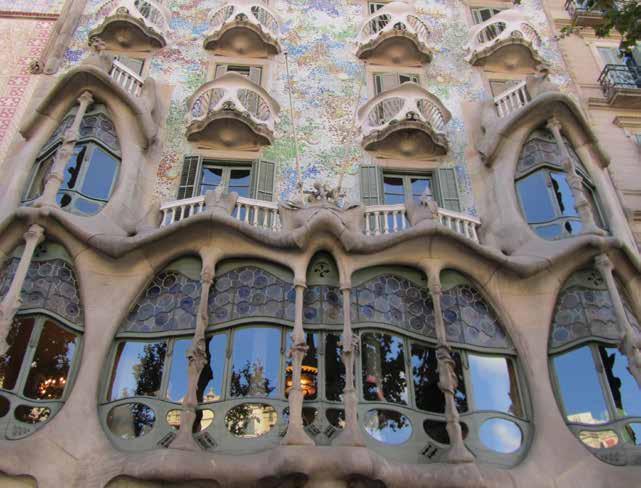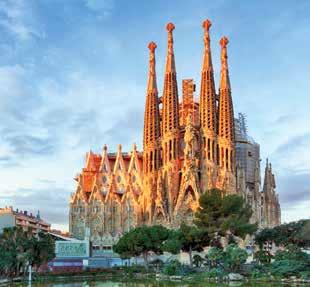
4 minute read
Honesty in the Face of Uncertainty
BEEN LONGING, BEING THERE, BEING BARCELONA
By Sylvia Jansen, DipWSET, CSW, Sommelier

Architect Antoni Gaudi’s ideas flow through Barcelona: Casa Batlló (above, photo by Carol Fletcher) and Park Güell (left, photo by nito/Adobe).
“Mucho calor,” remarked our taxi driver as we headed into the city from the airport. He did not need to tell us it was hot: even at 10:30 a.m. it was already 30°C. We found a small bar on a street corner that offered café solo (espresso) and tortilla de patatas, the ubiquitous potatoegg dish. We ate at a small table by the open window and spent the day searching for any corner of shade. But as the Canadian Prairies descend once again into the chill of fall and deep freeze of winter, I remember that Barcelona heat fondly. It paired nicely with the intense sun of the beach, refreshing glasses of Cava and rosado on shaded patios, nibbles of tiny treats on little plates, and a city as magical as it is varied.
The Rhythm
Capital of the fiercely independent Catalunya region, Barcelona has a special style and universal appeal. More than 5 million people live in the urban area, but Barcelona has more the feel of an assembly of neighbourhoods rather than a sprawling city. Following our late morning snack, we found the sun again in the Eixample district, with sunlit terraces along spacious boulevards. Only a short time later, we were exploring the Raval and Barri Gotic neighbourhoods, walking in tiny alley-narrow streets that seemed to live perpetually in the shade. In the heat of midday, the neighbourhoods grew quiet, as shops began to close for siesta (from about 2 p.m. to 5 p.m.). Bars and restaurants tend to break after lunch (about 4) until dinner service begins (about 9). Tapas bars took the time between. It did not take long to settle into the rhythm.
Indeed, it was the food and wine that stayed with us for a long time after departing Barcelona. The city is packed with amazing eateries, from little corner places to lively tapas bars and cutting-edge restaurants. (I will admit that one evening we never saw dinner, but rather a rambling sequence of tapas bars, with a few little bites and chilled rosado or Cava by the glass at each place.)
The city is blessed by the close proximity of wonderful Spanish wines, and the offerings of its bars and restaurants are a testament to these riches. The vast majority (95%) of Spain’s Cava is centred in the town of Sant Sadurni d’Anoia, less than an hour’s drive from the city. Barcelona restaurants offer interesting, quirky Cava options as well as premium selections from larger houses. Northern Spanish regions of Somontano, Rioja, Navarra, and Priorat are well represented in wine lists. But it does not stop there: easy-drinking Sangria is everywhere, wine lists sport a range of styles of Sherry from Spain’s deep south, and retro vermouth bars (vermuterias) offer the trendiest drinks going.

Font Mágica lights up the night above Barcelona
The Art
To be clear, we did not limit ourselves to eating and sipping. The work of the city’s famed architect, Antoni Gaudí, was high on my list of interests. We awoke on one of our first days at a ridiculously early hour (considering the time we had dined the night before) to avoid the line for entry to the Sagrada Familia. This immense church, which Gaudí began in 1883 and has been almost continually under construction, is a Barcelona landmark, with spires decorated by freeform ornamentation soaring into the sky. The Modernisme architectural style echoes almost everywhere. Even those whose main destination is the beach still find themselves staring from streetside onto building façades that almost teem with movement in organic, sculpted forms.
Barcelona is also an art lover’s dream, with an astounding array of galleries and museums (we found our way to the Picasso museum). We also sampled a selection of art for sale in the shops of the Raval and Gràcia. My friend and colleague Jill Kwiatkoski, also a Barcelona lover, has her own favourites, and told me her best rainy-day afternoon was spent touring the Museo del Jamón—the ham museum. Clearly, in Barcelona, one needs to think not what is best to see and do, but what is best at the moment.
Late in the evening, we turned from admiring buildings that seem alive to the street that is always alive: the famed Las Ramblas, where performers and flower vendors vie for the attention of those thousands of families and visitors walking its pavement. On another evening it was the Font Mágica, the light-show fountain at the base of the stairs to the National Museum of Catalan Art.
A few days in this city was enough to make me wish for more. Barcelona has lived through political tensions, fights Even those whose main destination is the beach still find themselves staring from streetside onto building façades that almost teem with movement in organic, sculpted forms.

In 1882, construction began on Gaudi’s Basílica de la Sagrada Família and continues to this day
for independence, random terrorism, and COVID-19. But its vibrancy, people, history, boulevards, and beaches have a timeless attraction. And like many others, I am longing to be there again. In the middle of our cold winter, I warm the morning with espresso in made-in-Catalunya café solo cups and soften the evening with a Somontano red or fun Cava. Nice to be back in Barcelona.










